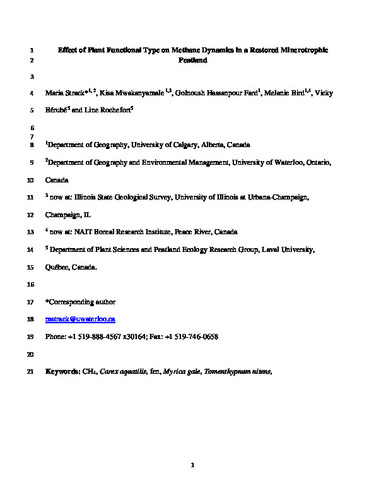| dc.contributor.author | Strack, Maria | |
| dc.contributor.author | Mwakanyamale, Kisa | |
| dc.contributor.author | Fard, Golnoush Hassanpour | |
| dc.contributor.author | Bird, Melanie | |
| dc.contributor.author | Bérubé, Vicky | |
| dc.contributor.author | Rochefort, Line | |
| dc.date.accessioned | 2022-10-19 14:37:40 (GMT) | |
| dc.date.available | 2022-10-19 14:37:40 (GMT) | |
| dc.date.issued | 2017-01 | |
| dc.identifier.uri | https://doi.org/10.1007/s11104-016-2999-6 | |
| dc.identifier.uri | http://hdl.handle.net/10012/18892 | |
| dc.description | This is a post-peer-review, pre-copyedit version of an article published in [insert journal title]. The final authenticated version is available online at: https://doi.org/10.1007/s11104-016-2999-6 | en |
| dc.description.abstract | Background and Aims: Peatland methane (CH4) fluxes may vary between plant types; however, in mixed communities, the specific role of each species is difficult to distinguish. The goal of this study was to determine the individual and interacting effect of moss, graminoid and shrub plant functional types on CH4 dynamics of experimentally planted plots in a rewetted minerotrophic peatland. Methods We measured CH4 flux, pore water CH4 concentration and CH4 production and oxidation potential in pure stands of reintroduced Tomenthypnum nitens (Hedw.) Loeske, Carex aquatilis Wahlenb, or Myrica gale L., as well as mixtures of T. nitens + C. aquatilis and T. nitens + M. gale. Methane flux was also measured on bare peat plots. ResultsThe presence of both the graminoid C. aquatilis and the shrub M. gale resulted in the highest CH4 production potential in near surface peat (10 cm). The presence of moss (T. nitens) and C. aquatilis significantly increased CH4 oxidation potential. Water table position was a significant control on CH4 flux, but the presence of C. aquatilis maintained higher flux even at dry plots. Plots including C. aquatilis had significantly lower pore water CH4 concentration at 30 cm depth, likely reflecting CH4 oxidation and transport. Conclusions Management of restored sites aiming to reduce CH4 flux should focus on hydrology, i.e. water table position. The presence of graminoids enhances CH4 flux, while moss presence may result in lower CH4 emission. | en |
| dc.language.iso | en | en |
| dc.publisher | Springer | en |
| dc.relation.ispartofseries | Plant and Soil; | |
| dc.subject | methane | en |
| dc.subject | Carex aquatilis | en |
| dc.subject | fen | en |
| dc.subject | Myrica gale | en |
| dc.subject | Tomenthypnum nitens | en |
| dc.title | Effect of Plant Functional Type on Methane Dynamics in a Restored Minerotrophic Peatland | en |
| dc.type | Article | en |
| dcterms.bibliographicCitation | Strack, M., Mwakanyamale, K., Hassanpour Fard, G., Bird, M., Bérubé, V., Rochefort, L. 2017. Effect of plant functional type on methane dynamics in a restored minerotrophic peatland, Plant and Soil, 410, 231-246, doi: 10.1007/s11104-016-2999-6. | en |
| uws.contributor.affiliation1 | Faculty of Environment | en |
| uws.contributor.affiliation2 | Geography and Environmental Management | en |
| uws.typeOfResource | Text | en |
| uws.peerReviewStatus | Reviewed | en |
| uws.scholarLevel | Faculty | en |

